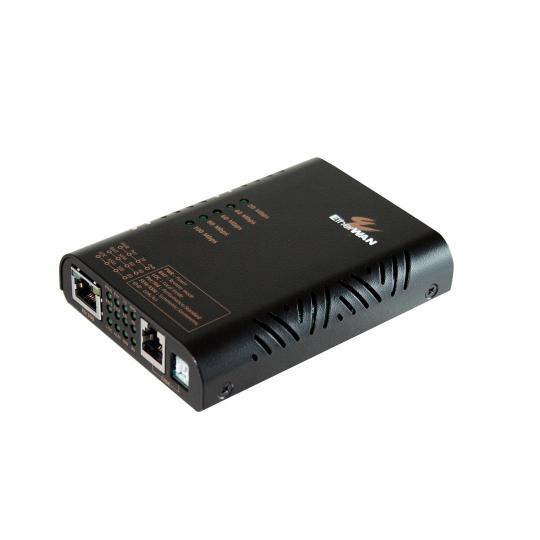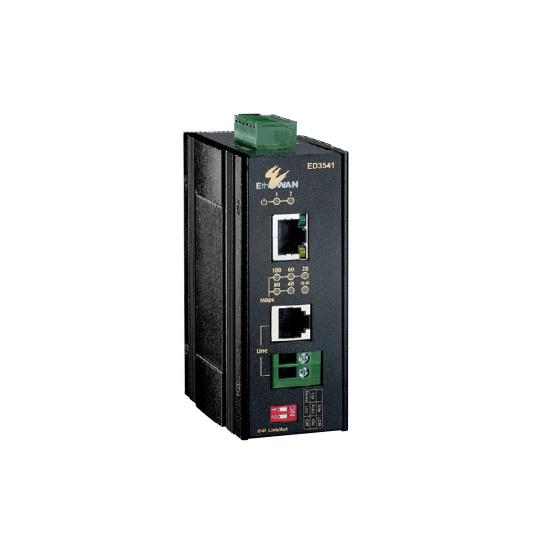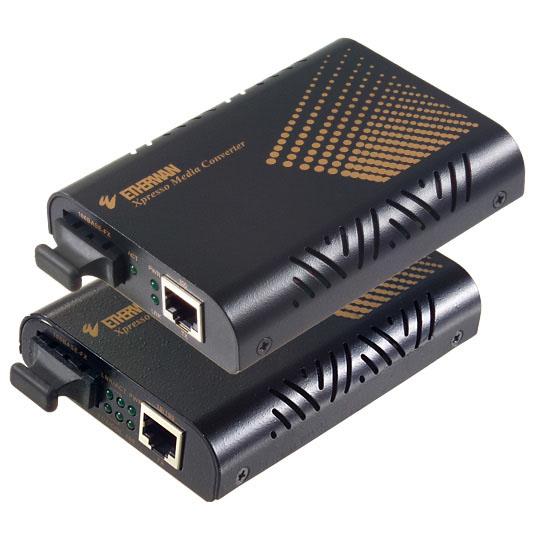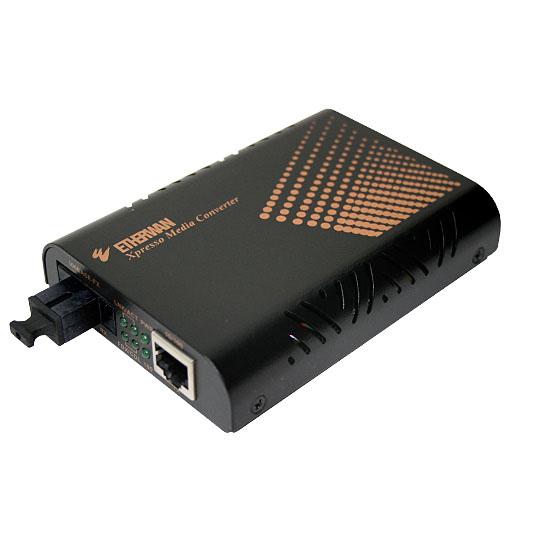IP Connectivity Migration
IP Connectivity MigrationContemporary control and management systems, such as industrial automation, building automation or access control and surveillance systems are changing the way they connect. Devices such as remote controllers, badge readers and CCTV cameras are now connecting via Ethernet and IP network connections rather than analog or slower serial connections. This migration of technologies requires different cabling infrastructure to support the higher speeds. Changing the cabling infrastructure can be costly and time consuming and in some cases impossible. EtherWAN has released a series of products that extend the life of existing cabling infrastructure, whether it's telephone cable, serial cable, coax cable or fiber optic cable, these products provide the interface between Ethernet and the existing cable infrastructure.
■ The product line
► ED3501
The ED3501 Ethernet extender allows the extension of IP services beyond normal Ethernet distance limitations without changing cables, breaking the 100-meter Ethernet barrier.
► ED3541
The ED3541 Ethernet extender allows the extension of IP services beyond normal Ethernet distance limitations without changing cables, breaking the 100 meter Ethernet barrier.
► ED3331
Converts 10/100 Ethernet (RJ45) to Coaxial cable. The ED3331 provides 85 Mbps Ethernet connectivity up to 200 meters and 1 Mbps up to 2,600 meters. This is a plug and play device with automatic speed selection based on signal quality and it has one switch setting for remote or local. This is the ideal device for converting analog CCTV cameras to IP cameras.
► ED3341
The hardened version of the ED3331, this device operates in harsh environments (-40ºC to 75ºC) and meets the tough standards of NEMA TS2 for traffic applications.
► EL200CA-2 & EL200CB-2 Converts
10/100 Ethernet (RJ45) to a single multi-mode fiber optic cable. These media converters use wavelength multiplexing methods to provide full duplex Ethernet connectivity over one single fiber, up to 2 km. These units are the perfect companion when converting an existing analog CCTV system to IP, they allow the user to utilize the existing fiber optic cable infrastructure with no loss of time or expense of pulling more cable.
► EL200CA-20 & EL200CB-20 Converts
10/100 Ethernet (RJ45) to a single single-mode fiber optic cable. These media converters use wavelength multiplexing methods to provide full duplex Ethernet connectivity over one single fiber up to 20km (longer distance is available). These units are the perfect companion when converting an existing analog CCTV system to IP, they allow the user to utilize the existing fiber optic cable infrastructure with no loss of time or expense of pulling more cable.
We are going to use security surveillance and access control systems as an example because they utilize both analog and serial connectivity, both of which are moving to IP connectivity. The trend to move security / Surveillance and access control systems to IP technology as the connectivity of choice is in full swing. However, there are millions of CCTV systems installed and operating. Analog systems not only use different electronics than IP technology, they also use different cables. A traditional CCTV system upgraded from analog to IP requires a complete overhaul of the entire wiring infrastructure, cables, patch panels, wall jacks etc. EtherWAN has a set of solutions that provide Ethernet connectivity over the traditional analog cable plant. We will show how traditional analog devices are connected, under different circumstances then show how EtherWAN products can be used to use the traditional cable plant to provide connectivity for new IP based equipment.

There are basically two types of CCTV cameras, fixed and PTZ or Pan Tilt and Zoom. Both of these cameras are generally connected to a video switcher that connects cameras to monitors and controls the PTZ functions. If cameras are within about 300 meters of the switcher they may be connected directly via coax cable or a composite cable with coax and serial communications, serial for PTZ control.
If cameras are too far to connect with coax, fiber optics is generally used as the media of choice. Several companies make "fiber optic modems" that convert electrical video signals to light signals and back. These devices are available in different configurations, one of which is a box that also transmits serial communications two ways as well as video one way, generally on a single fiber cable. The fiber cable installed may be multi-mode or single mode, it depends on the distance.
IP cameras, whether fixed or with PTZ have one communications interface, Ethernet, generally an RJ45 connector. Using Ethernet media conversion products EtherWAN can provide Ethernet connectivity for almost any existing cable infrastructure.

Whether the existing camera is PTZ or fixed it will be connected to the head end location via coaxial cable. The IP camera will have an RJ45 Ethernet port. By placing an ED3331 Ethernet Extender at each end of the coax cable we connect the camera through the coax to the network at the head end. The head end of an IP enabled CCTV system will consist of layer 2 and layer 3 Ethernet switches and control software running on a computer or workstation. The entire system is controlled through an Ethernet network carrying TCP/IP protocol. IP cameras generally connect to a Layer 2 switch, such as our EX3224 series or EX77000 series switches.
If an analog camera is connected via fiber optic cable then we put an EL200 WDM media converter at the camera end and connect the fiber optic directly to our switch which also has a WDM optical port. Most analog CCTV cameras have been deployed using a single multi-mode (MM) fiber optic cable so we will need to utilize our WDM over MM fiber capability to help users upgrade to an IP system. EtherWAN also has single-mode WDM media converters and Ethernet switches.
Access control systems generally consist of a central computer running control software and a network of remote terminal units (RTU) or remote controllers. In fact the same software generally controls the video switcher and cameras and the access control devices. The RTU interfaces with end security elements such as badge readers, keypads, door locks, motion sensors, window sensors, door sensors etc.
■ Typical Legacy Access Control Network Connectivity
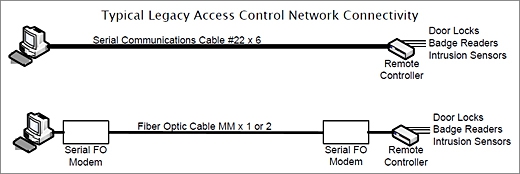
The typical access control system will use serial communications between the central computer and the RTU devices. If the distance is less than about 600 meters they will utilize standard serial communications cable using RS422 or RS485. If the distance is longer they will use fiber optic cable. In this case they may use 2 fiber optic cables and "serial fiber optic modems". In some instances they have also used a single fiber optic cable and WDM interfaces on the "serial fiber optic modems". In either case this is generally MM fiber optic cable.
We have various ways to offer Ethernet connectivity from the RTU to the central computer when a customer is upgrading to an IP based system, without changing any cable infrastructure. If a user is upgrading the head end but not the RTUs we can offer a two step approach as in the following diagram.

Using an SE5101 to convert the Serial interface on the RTU to Ethernet and use a pair of ED3101 Ethernet Extenders to transmit the Ethernet signal over the existing serial communications cable. At the head end the user uses virtual port software to communicate with the SE5101 and ultimately to the RTU.
If the user is converting the entire system to IP then the conversion is a single step process as shown below.

We use a pair of ED3101 Ethernet Extender units to provide Ethernet Connectivity over one pair of wires in the existing serial communications cable.
In the event that Fiber optics is used for this application it gets easier, as show below.

In this example we assume the system is being upgraded to a full IP based system. We use an EL100, if the fiber connection uses 2 fibers or an EL200 if it uses 1 fiber. These media converters convert the Ethernet connection to fiber optics and at the head end we provide a fiber optic based layer 2 Ethernet switches that allows the fiber to connect directly to the network. Of course you can also put a media converter at each end of the fiber to convert RJ45 to RJ45.
In the event that the user is not upgrading the RTU and needs a serial connection at this location, we simply replace the EL100 or EL200 with an SE5101 that has a fiber optic interface, of appropriate type, on the Ethernet side.

EtherWAN's media conversion products provide a more cost effective way to use your existing cable plant with new IP based systems.
The following diagrams show a complete CCTV system upgrade from Analog to IP.
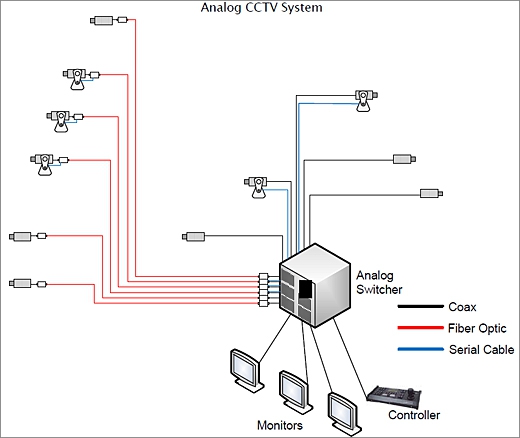
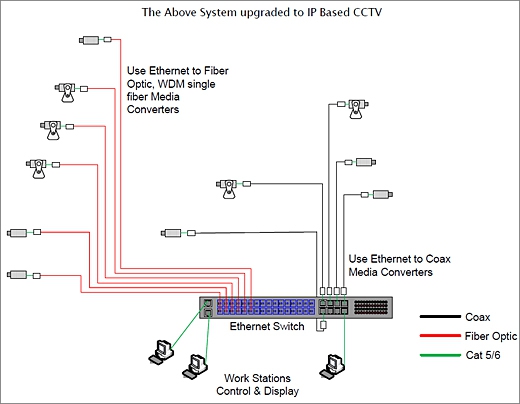
Do you have outdoor cameras? All of the equipment mentioned in this paper is available in hardened versions with an operating temperature of -40⁰C to 75⁰C and robust EMI/RFI parameters for mounting in outdoor cabinets. All of the hardened, industrial and commercial grade products are compatible with each other.
■ Equipment Referenced in this Document:
